Ogden Museum of Southern Art
925 Camp St
New Orleans, LA 70130
504.539.9650 | HOURS
925 Camp St
New Orleans, LA 70130
504.539.9650 | HOURS
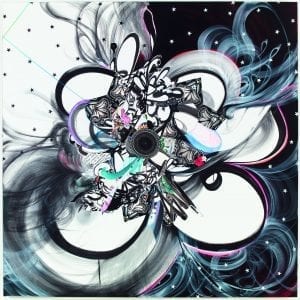
Shinique Smith (born 1971). “No Key, No Question”, 2013. Ink, acrylic, fabric, and collage on canvas over panel; 60 x 60 x 2 in. (152.4 x 152.4 x 5.1 cm). Photo by Jason Mandella, Courtesy David Castillo Gallery
/// November 18 @ 3:30 p.m. – 5 p.m.
Solidary & Solitary, drawn from The Joyner/Giuffrida Collection, tells the history of art by African American artists from the 1940s to the present moment. Focused primarily on abstract art, this exhibition celebrates the achievement of individual artists, the collective history told by their art, and the social changes that have changed the way we understand art history in the broadest sense.
This event is free and open to the public.
image credit: Shinique Smith (born 1971). No Key, No Question, 2013, Ink, acrylic, fabric, and collage on canvas over panel; 60 x 60 x 2 in. Photo by Jason Mandella, Courtesy of David Castillo Gallery
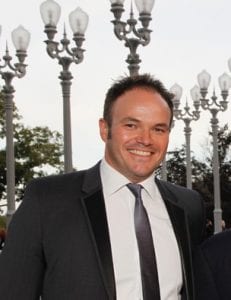 Christopher Bedford is the Dorothy Wagner Wallis Director of The Baltimore Museum of Art (BMA) and the 10th director to lead the museum, which is renowned for its outstanding collections of 19th-century, modern, and contemporary art. Recognized as an innovative and dynamic leader for building greater community engagement and creating programs of national and international impact, Bedford served as director of the Rose Art Museum at Brandeis University for four years prior to joining the BMA and was appointed as Commissioner for the U.S. Pavilion for the 2017 Venice Biennale, the world’s most prestigious contemporary art exhibition, which debuted an exhibition of new work by American artist Mark Bradford. Previously, Bedford held the positions of chief curator and curator of exhibitions at the Wexner Center for the Arts at The Ohio State University (2008-2012), where he organized a nationally traveling exhibition of the work of Mark Bradford. He also served as assistant curator and curatorial assistant in the Department of Contemporary Art at the Los Angeles County Museum of Art (2006-2008) and consulting curator in the Department of Sculpture and Decorative Arts for the J. Paul Getty Museum (2006-2008). Born in Scotland and raised in the United States and the UK, Bedford has a Bachelor of Arts from Oberlin College, received a master’s degree in art history through the joint program at Case Western Reserve University and the Cleveland Museum of Art, and has studied in the doctoral programs in art history at the University of Southern California and the Courtauld Institute of Art at the University of London. Bedford is also a noted author and contributor to publications including Art in America, ArtForum, and Frieze, among others.
Christopher Bedford is the Dorothy Wagner Wallis Director of The Baltimore Museum of Art (BMA) and the 10th director to lead the museum, which is renowned for its outstanding collections of 19th-century, modern, and contemporary art. Recognized as an innovative and dynamic leader for building greater community engagement and creating programs of national and international impact, Bedford served as director of the Rose Art Museum at Brandeis University for four years prior to joining the BMA and was appointed as Commissioner for the U.S. Pavilion for the 2017 Venice Biennale, the world’s most prestigious contemporary art exhibition, which debuted an exhibition of new work by American artist Mark Bradford. Previously, Bedford held the positions of chief curator and curator of exhibitions at the Wexner Center for the Arts at The Ohio State University (2008-2012), where he organized a nationally traveling exhibition of the work of Mark Bradford. He also served as assistant curator and curatorial assistant in the Department of Contemporary Art at the Los Angeles County Museum of Art (2006-2008) and consulting curator in the Department of Sculpture and Decorative Arts for the J. Paul Getty Museum (2006-2008). Born in Scotland and raised in the United States and the UK, Bedford has a Bachelor of Arts from Oberlin College, received a master’s degree in art history through the joint program at Case Western Reserve University and the Cleveland Museum of Art, and has studied in the doctoral programs in art history at the University of Southern California and the Courtauld Institute of Art at the University of London. Bedford is also a noted author and contributor to publications including Art in America, ArtForum, and Frieze, among others.
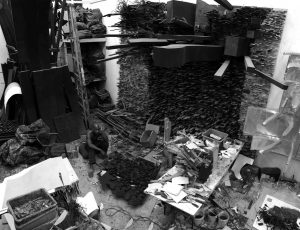
Photography by John Berens
Born in Tallahassee, Florida, 1961 BFA – Cooper Union, 1985
Lives and works in Brooklyn, New York
Practicing an evolutionary approach to his art, Leonardo Drew is in a constant state of making and unmaking his large-scale sculptural assemblages. “I just take old work and turn it into new work. There’s always layering and that happens because life is going on, so you’re layering your experiences.”1
Growing up in public housing in Bridgeport, Connecticut, Drew’s process is in uenced by his early memories of an adjacent land ll and rendering plant for soap. Seeing vehicles enter with dead animals, and the notion that the material we use to make us clean is derived from decay was formative: “And to this day I can still smell it. It still affects me and informs my creative oeuvre. Number 8, the mother to all of my works, speaks of that experience most eloquently.” 2
Instead of collecting found objects to create his works, he uses natural substances like wood, iron, cotton, and paper and then subjects them to a range of processes like staining and dyeing that mimics weathering, burning, oxidization, and decay. Creating sculptures in forms that move: they dangle, reach, ooze, lay, drip, drawing the viewer in, Drew leads us to examine the relationship between part and whole and to wonder how he mimics natural processes.
Using a categorization system for titles, Drew’s “L-” series was created in London, “T-”s were made in Texas, and “S-”s in San Francisco.3 The work 52S appears to be constructed of wood charred black, arranged into a tight but uneven grid evoking an aerial view of a metropolis with a cluster of pale interwoven branches that simultaneously spring forth and are swallowed in the center of the work.
Although initially recognized for his talent as a draughtsman and even recruited by Marvel Comics, DC Comics, and Heavy Metal Magazine, Drew knew he had to seek other ways of creating. “I was doing a lot of exhibiting of a type of work that showed off my facility, from when I was 13 up until my second year of college. I said, “Enough of this.” What I did was, “Tie your hands. No more drawing, no more painting. Find another way. You have to nd another way.” It took, if I remember, seven years – it was ’82 roughly to ’88, ’89. What ended up happening was Number 8 (The Mother). Numbers 1-7 became Number 8.4
1Ugelvig, Jeppe. “Leonardo Drew’s Undulating Wood Sculptures Question the Natural.” Artsy.net
2Proenza, Mary. “Leonardo Drew at Sikkema Jenkins.” ArtInAmericaMagazine.com. Brant Publications, January 8, 2013.
3Weiss, Haiey. “Leonardo Drew and The Mother.” InterviewMagazine. com. Jason Nikic, September 29, 2016.
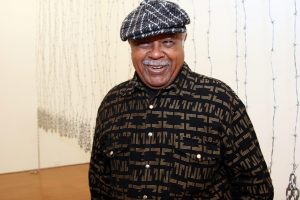
Melvin Edwards, 2012
Courtesy Alexander Gray Associates, New York
Born in Houston, Texas in 1937
BFA – University of Southern California, 1965 Lives and works in New York and New Jersey, USA and Dakar, Senegal
Melvin Edwards is known for his welded steel sculptures that combine familiar tools, weapons, and shapes into new formations, which allow him to physically interact with his medium and explore how these works can convey human and political realities.
Seeking to explore the world outside his hometown, Edwards initially enrolled at the University of Southern California with a football scholarship, but after an injury, he renewed his interest in art making. Although a high school teacher had introduced him to the concept of abstraction, he found himself rebelling against the prevailing idea of “art for art’s sake” put forth by Clement Greenberg and other proponents of Abstract Expressionism, focusing instead on spiritual, therapeutic, religious, and political motivations for his own practice.1
Finding deep connections to the Civil Rights movement, Edwards began his Lynch Fragment series in 1963, in the aftermath of the police killing of the Black Muslim Ronald T. Stokes. In the work Central Ave. LA, chains, padlocks, barbed wire, spades, and hooks evoke the history of slavery, imprisonment, chain gangs, forced labor, racist curses, and lynching, but the placement of the sculptures high on the wall could be a reminder, for some, of heraldry or the elevated position of African ceremonial masks.2
Edwards also found inspiration for the Lynch Fragments in jazz, speci cally in the work of musicians who were also breaking down and reforming existing structures and concepts, like Charlie Parker, Miles Davis, John Coltrane, Sonny Rollins, and Thelonious Monk.3
Speaking about his methods, Edwards explains, “Once I started to weld steel, I realized much of the world I lived in is welded. I’d be driving behind a truck, and it’s got a tailgate, and I realize: Oh, all of that, that tailgate, that’s welded – and it’s a beautiful relief sculpture. You can just see it, because you’re used to seeing those things in process.”4
1Kino, Carol. “Rediscovering Someone Recognized.” NYTimes.com. Arthur Ochs Sulzberger Jr, October 17, 2012
2Godfrey, Mark. “Abstraction in Tryin’ Times, 1967–1980.” Four Generations: The Joyner/Giuffrida Collection of Abstract Art. Gregory R. Miller & Co., New York. 2016.
3Zotos, John. “Melvin Edwards: Five Decades Review”. NasherSculptureCenter.org. May 10, 2015.
4Zotos, John. “Melvin Edwards: Five Decades Review”. NasherSculptureCenter.org. May 10, 2015.
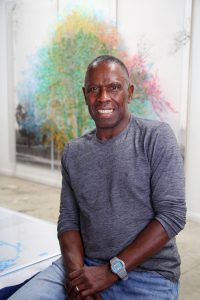
“Headshot 1 & 7” – Courtesy of the Artist and Paula Cooper Gallery, New York. Photography by Katie Miller
Born in Charleston, South Carolina in 1944 BA—Jersey City State College in 1966 MFA—Rochester Institute of Technology, School of Art and Design in 1967
Lives and works in Los Angeles, California
A second-generation conceptualist artist, Charles Gaines is known for his “gridwork” – highly structured works encompassing photography, painting, and drawing. Gaines creates densely layered works that explore how rules and systems in uence the way we think.
As the son of a construction worker and seamstress living in South Carolina, Gaines was identi ed as talented at a young age. “My teacher told my mom that she should encourage me to go into art because I could be the ‘ rst black artist. Of course, there was already a rich black history in art, but nobody knew it because it wasn’t taught.”1 Gaines went on to become a highly regarded conceptualist artist and educator, teaching an alternate art history, one that included black artists and demanded the same consideration for the artist’s product no matter their skin tone, leaving a strong impression on many of his students at CalArts, including Mark Bradford.2
Although Gaines experimented with guration and abstraction in painting, he ultimately looked for a different way to communicate his ideas, one that took the expression and the ego out of painting. Formed by his childhood experience growing up in the Jim Crow era in South Carolina, he was distrustful of procedures, rules, and systems. Approaching life in a more esoteric way, embracing the Tantric Buddhist principles of achieving clarity and purpose through rigorous self-control, Gaines sees his grid-like drawings and paintings as a form of meditation, elevating the viewer to a trancelike state, during which inner voices, needs, and wants can be calmed or even silenced. “These drawings are not a function of the expression of the monks that produced them,” he explains. “They are a manifestation of a Zen-like practice.”3
Turning away from both guration and abstraction, Gaines began to create a series of dense hand-drawn grids used to trace the movements of choreographer Trisha Brown, mathematical equations, and trees. The work Numbers and Trees: Central Park Series I: Tree #9, even in its pixelated form, is representative of a tree, even if it isn’t representational. In this way Gaines plays with conceptualism, pushing the boundaries of art while demonstrating the limits of his material, whether in photography, painting, or drawing.
1Miranda, Carolina A. “How the dense grids of artist Charles Gaines took the ego out of art.” LATimes.com. Tronc, Incorporated. March 3, 2015.
2Jamillah James on Charles Gaines. Four Generations: The Joyner/ Giuffrida Collection of Abstract Art. Gregory R. Miller & Co., New York. 2016.
3Miranda, Carolina A. “How the dense grids of Charles Gaines took the ego out of art.” LATimes.com. Tronc, Incorporated. March 3, 2015.
 Katy Siegel is the inaugural Eugene V. and Clare E. Thaw Endowed Chair in Modern American Art at Stony Brook University, and Senior Curator for Research and Programming at The Baltimore Museum of Art. She is the co-curator with Christopher Bedford of Mark Bradford’s exhibition at the U.S. Pavilion for the 2017 Venice Biennale, and co-curator with Okwui Enwezor and Ulrich Wilmes of Postwar: Art Between the Atlantic and the Pacific, 1945-1965, at the Haus der Kunst, Munich. Past exhibitions have included Rosalyn Drexler: Who Does She Think She Is?. Pretty Raw: After and Around Helen Frankenthaler, Light Years: Jack Whitten, 1971-1974, and High Times Hard Times: New York Painting, 1967-75, which toured internationally and received an award from AICA. Her edited volumes include “The heroine Paint”: After Frankenthaler (2015) and Abstract Expressionism (2011); she is the author of Since ’45: America and the Making of Contemporary Art, which details the collision of American social history and European modernism (2011). She has written criticism and historical essays on contemporary and modern art for numerous institutions internationally, and is a Contributing Editor at Artforum, and Consulting Editor at The Brooklyn Rail. From 2010-2013 she was the Editor in Chief of Art Journal.
Katy Siegel is the inaugural Eugene V. and Clare E. Thaw Endowed Chair in Modern American Art at Stony Brook University, and Senior Curator for Research and Programming at The Baltimore Museum of Art. She is the co-curator with Christopher Bedford of Mark Bradford’s exhibition at the U.S. Pavilion for the 2017 Venice Biennale, and co-curator with Okwui Enwezor and Ulrich Wilmes of Postwar: Art Between the Atlantic and the Pacific, 1945-1965, at the Haus der Kunst, Munich. Past exhibitions have included Rosalyn Drexler: Who Does She Think She Is?. Pretty Raw: After and Around Helen Frankenthaler, Light Years: Jack Whitten, 1971-1974, and High Times Hard Times: New York Painting, 1967-75, which toured internationally and received an award from AICA. Her edited volumes include “The heroine Paint”: After Frankenthaler (2015) and Abstract Expressionism (2011); she is the author of Since ’45: America and the Making of Contemporary Art, which details the collision of American social history and European modernism (2011). She has written criticism and historical essays on contemporary and modern art for numerous institutions internationally, and is a Contributing Editor at Artforum, and Consulting Editor at The Brooklyn Rail. From 2010-2013 she was the Editor in Chief of Art Journal.

Photograph Gary Pennock. Courtesy the artist and David Castillo Gallery.
Born in Baltimore, Maryland in 1971
BFA – Maryland Institute College of Art, 1992 MFA – Maryland Institute College of Art, 2003 MAT – Tufts University
Lives and works in New York, New York
Shinique Smith is an artist known for her large- scale canvases, as well as installations and sculpture repurposing the things that humans discard: clothing, stuffed animals, shoes. Smith’s young life was strongly in uenced by her mother, a fashion designer known for creating “wildly sculptural” crocheted pieces, and who often took young Shinique along to the Tibetan Meditation Center where she would fall asleep to the soothing sound of the monks’ chanting. At the age of twelve, Smith began her study at the Baltimore School for the Arts, receiving extensive instruction in life drawing and painting.1
These in uences can be seen in Smith’s embrace of nontraditional materials and her method of creating dense layers – in her paintings as well as in her sculptures – that capture the tension between freedom and constraint, planning and improvisation, and gravity and weightlessness. Smith’s con dent marking of line also derives from her graduate school study of calligraphy and her brief membership in a graf ti crew as a high school student.
Explaining her piece, No Key, No Question, Smith says, “The title is extracted from a poem. To me, the words describe an absolute understanding, one that does not require a question or an answer. There is no lock, so there is no need of a key. At the time I made it, my imagination was captured by the detection of the Higgs boson and the imaging of proton-proton collisions. […] Throughout my work, I attend to small moments and overall composition so that one’s focus shifts while observing, as my focus shifted in their making.” 2
As an art educator and artist, Smith frequently involves student artwork in her monumental public installations, created for the New York Metro, Los Angeles Metro Transit Authority, and the Chicago Transit Authority, among others.3
1Sheets, Hillarie M. “Giving Castoffs a Second Life.” NYTimes.com. Arthur Ochs Sulzberger Jr., March 7, 2013
2Jen Mergel in Conversation with Shinique Smith. Four Generations: The Joyner/Giuffrida Collection of Abstract Art. Gregory R. Miller & Co., New York. 2016.
3Sheets, Hillarie M. “Giving Castoffs a Second Life.” NYTimes.com. Arthur Ochs Sulzberger Jr., March 7, 2013